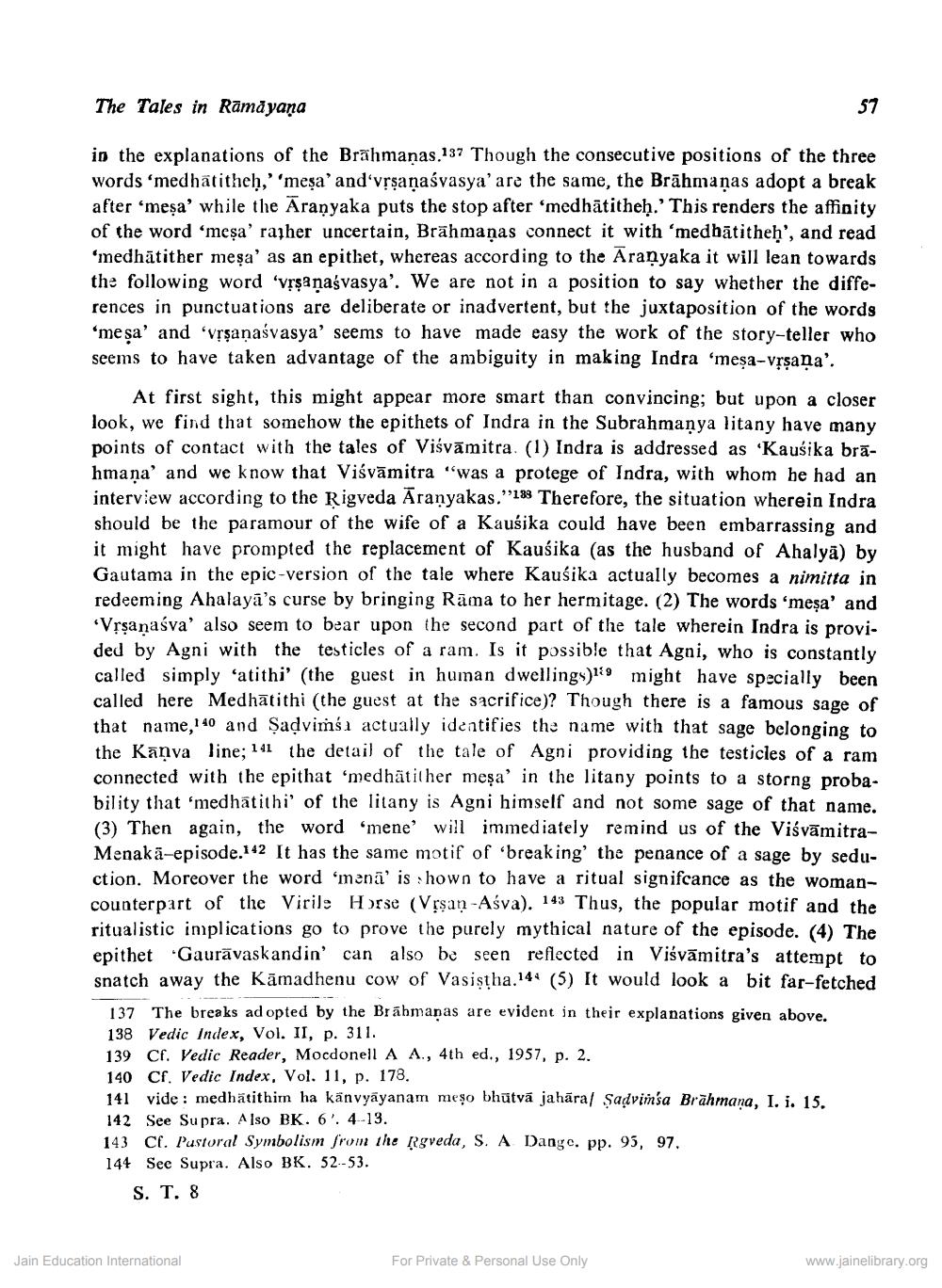________________
The Tales in Ramayana
in the explanations of the Brahmanas.137 Though the consecutive positions of the three words 'medhätitheh,' 'meṣa' and'vṛṣaṇaśvasya' are the same, the Brahmanas adopt a break after 'meşa' while the Aranyaka puts the stop after 'medhätitheḥ.' This renders the affinity. of the word 'mesa' rather uncertain, Brahmanas connect it with 'medhātitheḥ, and read 'medhätither meşa' as an epithet, whereas according to the Aranyaka it will lean towards the following word 'vrsanaśvasya'. We are not in a position to say whether the differences in punctuations are deliberate or inadvertent, but the juxtaposition of the words 'meṣa' and 'vrşanṇaśvasya' seems to have made easy the work of the story-teller who seems to have taken advantage of the ambiguity in making Indra 'mesa-vrsana'.
At first sight, this might appear more smart than convincing; but upon a closer. look, we find that somehow the epithets of Indra in the Subrahmanya litany have many points of contact with the tales of Visvamitra. (1) Indra is addressed as Kausika brähmana' and we know that Visvamitra "was a protege of Indra, with whom he had an interview according to the Rigveda Aranyakas." Therefore, the situation wherein Indra should be the paramour of the wife of a Kausika could have been embarrassing and it might have prompted the replacement of Kausika (as the husband of Ahalya) by Gautama in the epic-version of the tale where Kaušika actually becomes a nimitta in redeeming Ahalaya's curse by bringing Rama to her hermitage. (2) The words 'mesa' and 'Vrṣaṇaśva' also seem to bear upon the second part of the tale wherein Indra is provided by Agni with the testicles of a ram. Is it possible that Agni, who is constantly called simply 'atithi' (the guest in human dwellings) might have specially been called here Medhätithi (the guest at the sacrifice)? Though there is a famous sage of that name,140 and Saḍvimša actually identifies the name with that sage belonging to the Kanva line; 14 the detail of the tale of Agni providing the testicles of a ram connected with the epithat 'medhätither meşa' in the litany points to a storng probability that 'medhätithi' of the litany is Agni himself and not some sage of that name. (3) Then again, the word 'mene will immediately remind us of the VisvamitraMenaka-episode.142 It has the same motif of 'breaking' the penance of a sage by seduction. Moreover the word 'mena' is shown to have a ritual signifcance as the womancounterpart of the Virile Horse (Vgsan-Aśva). 143 Thus, the popular motif and the ritualistic implications go to prove the purely mythical nature of the episode. (4) The epithet Gaurävaskandin' can also be seen reflected in Visvamitra's attempt to snatch away the Kamadhenu cow of Vasistha.14 (5) It would look a bit far-fetched 137 The breaks ad opted by the Brahmanas are evident in their explanations given above. 138 Vedic Index, Vol. II, p. 311.
139 Cf. Vedic Reader, Mocdonell A A., 4th ed., 1957, p. 2.
140 Cf. Vedic Index, Vol. 11, p. 178.
141 vide medhätithim ha känvyayanam meşo bhütva jahara/ Sadvimsa Brahmana, I. i. 15. 142 See Supra. Also BK. 6'. 4-13.
143 Cf. Pastoral Symbolism from the Rgveda, S. A Dange. pp. 95, 97.
144 See Supra. Also BK. 52-53.
S. T. 8
Jain Education International
57
For Private & Personal Use Only
www.jainelibrary.org




